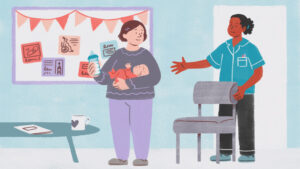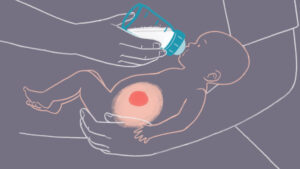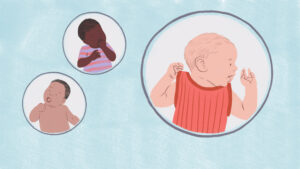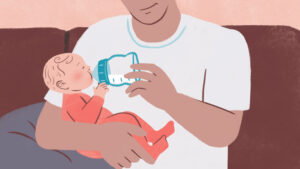Feedback on our responsive feeding campaign
Kent Health Visiting Team would appreciate your feedback on our responsive feeding campaign featuring the ‘feeding your baby responsively’ and ‘responsive feeding from six months’ animations by answering our five-minute survey. This survey is open to any professional working with families in Kent. If you are a member of the public, please complete our public survey.
We need to start thinking about supporting healthy growth during pregnancy and from birth.
 You can support parents to use responsive feeding techniques to help their children grow in a healthy way that is right for them, while also helping them develop a close and loving bond with their child, by promoting responsive bottle-feeding, if parents choose not to breastfeed.
You can support parents to use responsive feeding techniques to help their children grow in a healthy way that is right for them, while also helping them develop a close and loving bond with their child, by promoting responsive bottle-feeding, if parents choose not to breastfeed.
The campaign features three animations and additional information on the webpage that should be used to complement your existing knowledge or staff training.
This campaign will only be shared with staff and is not for public awareness. An animation for parents is available on our 'Responding to Baby' page.
Why is responsive bottle-feeding important?
We know breastfeeding has many benefits. Babies who are breastfed are less likely to grow up to be overweight or obese as they control how much milk they take from the breast.
 Signpost families to www.besideyoukent.co.uk for more support and information on breastfeeding. However, some parents will choose, or need to bottle-feed their baby with formula or expressed breastmilk.
Signpost families to www.besideyoukent.co.uk for more support and information on breastfeeding. However, some parents will choose, or need to bottle-feed their baby with formula or expressed breastmilk.
It's much easier to overfeed a bottle-fed baby compared to a breastfed baby. This can lead to bottle-fed babies ignoring their own feelings of fullness and taking in more calories than they need. Over time this makes it harder to recognise when they are full or regulate how much they eat.
 Newborn stomachs are very small, only the size of a marble and then only increase in size slowly, so a baby can get full quickly. If bottle-fed babies take more than they need, their stomachs can be overstretched and may become bigger than they might have been, leading them to need more milk to feel full.
Newborn stomachs are very small, only the size of a marble and then only increase in size slowly, so a baby can get full quickly. If bottle-fed babies take more than they need, their stomachs can be overstretched and may become bigger than they might have been, leading them to need more milk to feel full.
Evidence suggests babies fed expressed breastmilk are less likely to gain weight than those fed formula from a bottle but are still more likely to be overfed than breastfed children.
The good news is that parents can use responsive feeding techniques to prevent overfeeding. If a parent or parents are opting for bottle-feeding, you can support them to use responsive bottle-feeding to help their child grow healthily while also developing a close and loving bond. Visit Kent Family for more information on bonding and encouraging brain growth.
Some fact and figures

- One in four children starting primary school is above a healthy weight. Even more will be above a healthy weight when they leave school.
- This leads to young people growing up to be overweight or obese.
- Two in three adults are now above a healthy weight with a predicted 70 per cent of adults living with obesity by the 2030s.
- Obesity increases the risk of diabetes, cardiovascular disease and poor mental health in later life.
What is responsive bottle-feeding?
Responsive bottle-feeding is responding to baby's hunger and fullness cues.
Help parents spot signs their baby is getting hungry rather than stick to a set routine.
 Babies may:
Babies may:
- stick their tongue out or smack their lips
- suck on their fists
- turn their head to find milk.
Crying doesn't always mean a baby is hungry and needs a feed. Feeding a bottle-fed baby every time they cry can lead to overfeeding. You cannot overfeed a breastfed baby, parents should be encouraged to feed their baby at the breast for their or their or their baby's comfort.
Let bottle-feeding parents know they can comfort their baby in other ways with a cuddle or wearing them in a sling if they aren't showing any other hunger cues. Kent Baby has more supportive information on baby behaviour and how to cope with crying.
Show parents how to hold their baby when bottle-feeding

- Hold baby close and fairly upright, with their head supported - so they can breathe and swallow comfortably. Babies shouldn’t be flat on their backs or left alone with a propped-up bottle when they are being fed, as they can choke.
- Start by stroking their top lip to get them to open their mouth.
- Hold the bottle with a slight tilt so they’re not overwhelmed with the flow. Let the baby take the lead.
Give baby a break
- Babies feed in bursts of sucking with short pauses to rest. When baby slows down, remove the teat and then let baby draw it in again.
- Give baby a wind during the feed.
- Giving baby a break can help them register how full they are and how much more they need – helping them to control their intake. Holding the bottle with a slight tilt will allow baby to pause for a rest.
 Giving baby a wind during the feed also gives them a break.
Giving baby a wind during the feed also gives them a break.- Babies shouldn’t be forced to finish their bottle.
- Suggest parents talk to their baby gently and look into their eyes to reassure them during feeds. This helps them to feel safe and loved, helping to build the bond between parent and child as well as supporting brain development. Having only a couple of people feed the baby helps that special bond to grow.
Help parents spot signs their baby is getting full
 Babies might push out the teat, not pull it back into their mouth or they might start dribbling milk.
Babies might push out the teat, not pull it back into their mouth or they might start dribbling milk.- They may turn their head or push the bottle away.
- Once the parent knows their baby has had enough, they can take the bottle away and give their baby a gentle winding. Keeping baby upright for ten minutes is helpful.
What happens if parents don’t respond to their baby?
- Babies who are overfed with a bottle will take in more calories and start to ignore their own feelings of fullness. This could lead to not knowing when they are full or being able to regulate how much they eat.
- Their stomachs can be stretched and may become bigger than they might have been.
There is specialist help available for all parents however they feed their baby including help to exclusively breastfeed if they want to. Kent Baby has expert NHS advice on all aspects of feeding and infant development.
Responsive feeding from six months
From six months, parents can introduce solid food alongside their baby’s usual milk feeds. The World Health Organisation recommend women continue to breastfeed for two years or beyond and for as long as the woman and child are happy to continue.
How much a baby takes is less important than getting them used to the idea of eating, alongside all the new tastes and textures they’ll experience. Start with small amounts as most of their calories and nutrients will still come from breast or first-stage formula milk.
Signs an older baby is full:
- closing their mouth
- turning head away or pushing food away.
How much a baby chooses to eat is down to them. Reassure parents that babies and small children’s appetites vary day-to-day, if they’re unwell or having a growth spurt. Responsive feeding allows parents to adapt to their child’s changing needs. Encourage parents to eat together with their children to promote good eating habits and communication skills.
Partnership
Kent Community Health NHS Foundation Trust (KCHFT) and Kent County Council (KCC) have developed this responsive bottle-feeding campaign aimed at health and early-years professionals to support our aim of improving parents’ knowledge on how to feed their baby responsively.
In February 2023, Kent's Health Visiting Service and children’s centres were reviewed by Unicef as part of our journey to recertify and reach Gold standard in the Baby Friendly Initiative Standards.
Helping parents to understand responsive bottle-feeding and improving parents’ knowledge of the importance of developing close and loving relationships for short and long-term emotional health and brain development were two key areas highlighted to better support parents.